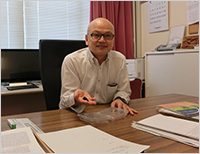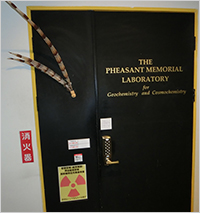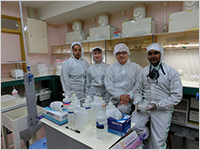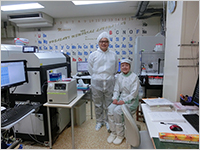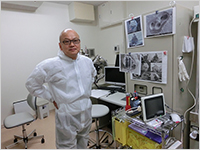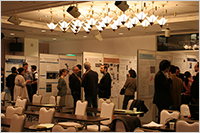Enlarge Image Entrance to Pheasant Memorial Laboratory (PML) with the pheasant’s feathers.
Enlarge Image Eizo Nakamura with research staff inside a clean room at the Okayama University Pheasant Memory Laboratory (PML), Institute for Study of the Earth’s Interior (ISEI).
Enlarge Image Eizo Nakamura with research staff inside a clean room at the Okayama University Pheasant Memory Laboratory (PML), Institute for Study of the Earth’s Interior (ISEI).
Enlarge Image Eizo Nakamura in the focused ion beam system (FIB) room with images of the particles retrieved by the Hayabusa mission from a near-Earth asteroid 25143 Itokawa.
Enlarge Image Poster session at the Misasa V International Symposium 2015 (http://sympo.misasa.okayama-u.ac.jp/misasa_v/)
Enlarge Image
The Institute for Study of the Earth's Interior, Okayama University
Insights into ‘comprehensive analysis’ based research at one of the world’s pioneering planetary science institutes located in a quite historical Japanese hot spring town
Eizo Nakamura,
Director, Professor of Geochemistry of the Institute Study of the Earth’s Interior (ISEI), and
Head of the Pheasant Memorial Laboratory for Geochemistry and Cosmochemistry
Okayama University at Misasa
Pheasant Memory Laboratory (PML)
Professor Eizo Nakamura is the head of the Okayama University’s Pheasant Memory Laboratory (PML) at ISEI located in Misasa Town, Tottori Prefecture—a small town renowned for its hot springs [1]. Nakamura is internationally recognized for his pioneering contributions to research on elucidating the origin, evolution, and dynamics of the solar system. “I believe that the 21st century will be the ‘era of solar system exploration’”, says Nakamura. “It is an exciting time in solar system research as was highlighted during the Misasa International Symposium 2015 we organized recently.”
Nakamura’s words reflect recent scientific advances in solar system research in part facilitated by unprecedented developments in engineering and technology to launch and remotely control sophisticated scientific analytical instruments onboard spacecraft for on-site scientific measurements of the physical properties of asteroids, comets, and planets including Mars. Important milestones in solar system research include the sample return mission of Japan’s Hayabusa probe launched 2003 to touch the surface of the asteroid 25143 Itokawa; the on-site science of NASA’s Curiosity, Mars Science Laboratory mission that landed at the Gale Crater on Mars in 2012; and the European Space Agency ‘comet chaser’ Rosetta Mission launched in 2004 that succeeded in landing the probe Philae onto the surface Comet 67P/Churyumov-Gerasimenko in November 2014 as it hurtles towards the sun.
The history of the Institute for Study of the Earth’s Interior (ISEI) goes back to 1939 and the establishment of the ‘Misasa Hot Spring Rehabilitation Center, Okayama Medical College’. Then after several reorganizations, the ISEI was set up in 1985 as a ‘Nationwide Joint-use Research Center’. “The reason the PML is called the ‘pheasant memory laboratory’ is because many years ago we found a dead pheasant near the lab,” explains Nakamura. “Hence the ‘pheasant memorial lab’. In fact, the pheasant’s tail feathers decorate the entrance to one of the clean rooms to PML!” (see photograph below).
Research and education programs
“Our ‘comprehensive analysis’ based research at PML has made unique and pioneering contributions to human knowledge of the physico-chemical properties of terrestrial and extra-terrestrial materials,” explains Nakamura. “Our staff consist of tenured faculty as well as highly motivated interns and doctoral students from all over the world.” Educational scholarships offered at ISEI include the 5-year doctoral course at the Division of Earth and Planetary Materials Science [2] and the Misasa International Student Intern Program [3]. “This was the first such five year integrated Ph.D. course in Japan,” says Nakamura. “Education and research is conducted in English so we attract many highly talented young people from overseas. The selection criteria, structure of courses, and welfare facilities are based on my personal experiences of studying for my doctorate at The University of Toronto and the Australian National University, post graduate research at Department des Sciences de la Terre, Universites de Paris 6 &7, and lecturing at institutes including Harvard University. I know what it is like to be a student in a foreign country.”
Research facilities
Research at PML is conducted using state of the art analytical instruments housed in dedicated cleanrooms with unique air flow systems to prevent contamination of samples [4]. “In my early years at ISEI I expended a lot of time and effort in designing and constructing the clean rooms,” says Nakamura. “The facilities are unique. They cannot be bought off the shelf. The ISEI infrastructure is the result of years of exhaustive, evolutionary trial and error experiments with all my colleagues at Misasa to produce the most comprehensive facilities in the world. We share these instruments with colleagues all over the world including NASA, ESA, and Russia.”
The experimental facilities at ISEI are maintained by so-called ‘super technicians’, who have doctorates and can allocate time to conduct their own research in addition to their other duties. “This idea resulted by the need to create a ‘post-doc safety net’,” says Nakamura. “We have funding to hire 10 super technicians.”
Research highlights and the future
Nakamura and colleagues analyzed the particles retrieved by the Hayabusa mission to a near-Earth asteroid 25143 Itokawa [5, 6]. The results—the first reported analysis of grains taken directly from a solar body in space—showed craters 100-200 nm in size and particles stuck to the asteroid surface. The analysis suggests that a combination of disaggregation, cratering, melting, adhesion, agglutination, and implantation/sputtering affect the asteroid surface as a result of bombardment by sub-micrometer sized particles in space. The researchers suggest that "the chemistry and textures of Itokawa's surface reflect long-term bombardment of equilibrated chondritic material, at scales of 1e−9 to 1e4 meters". They add that impact processes in general play a central role in the evolution of planetary bodies.
Nakamura and colleagues will also analyze the results of the Hayabusa 2- launched by JAXA in late 2014 for a return mission to dock with C-type asteroid 1999JU2 on 2018 and return to Earth in 2020.
Another project is focused on solving the mysteries of the Chelyabinsk meteor that illuminated the skies over Russia in February 2013 [see photograph].
What does the future hold? Nakamura has his gaze on the hot water fluid permeating the surface of Misasa—one of the most famous hot springs with a history going back several hundred years [7]. “The hot spring water emanating here comes from deep inside the Earth,” says Nakamura. “So it carries a lot of information about the crust, mantle ultimately the origin of the Earth, and life. Recently, we have been analyzing the local hot spring water for insights about the origin of life and its use for treatment of medical ailments.”
Further information
[1] Institute for Study of the Earth's Interior Okayama University: http://www.misasa.okayama-u.ac.jp/eng/
[2] Misasa V International Conference 2015 (Comprehensive Exploration of the Solar System) : http://sympo.misasa.okayama-u.ac.jp/misasa_v/
[3] Misasa International Student Intern Program: http://www.misasa.okayama-u.ac.jp/~misip/intern.php
[4] Experimental facilities: http://www.misasa.okayama-u.ac.jp/eng/facilities/#fa_top
[5] Okayama University e-Bulletin: Research Highlights
Evolving planets get a bumpy ride, http://www.okayama-u.ac.jp/user/kouhou/ebulletin/pdf/vol1.pdf
[6] Eizo Nakamura et.al, “Space environment of an asteroid preserved on micrograins returned by the Hayabusa spacecraft”, Proceedings of the National Academy of Science 109, E624-E629 (2012).
[7] Misasa Onsen: http://spa-misasa.jp/eng/index.html

